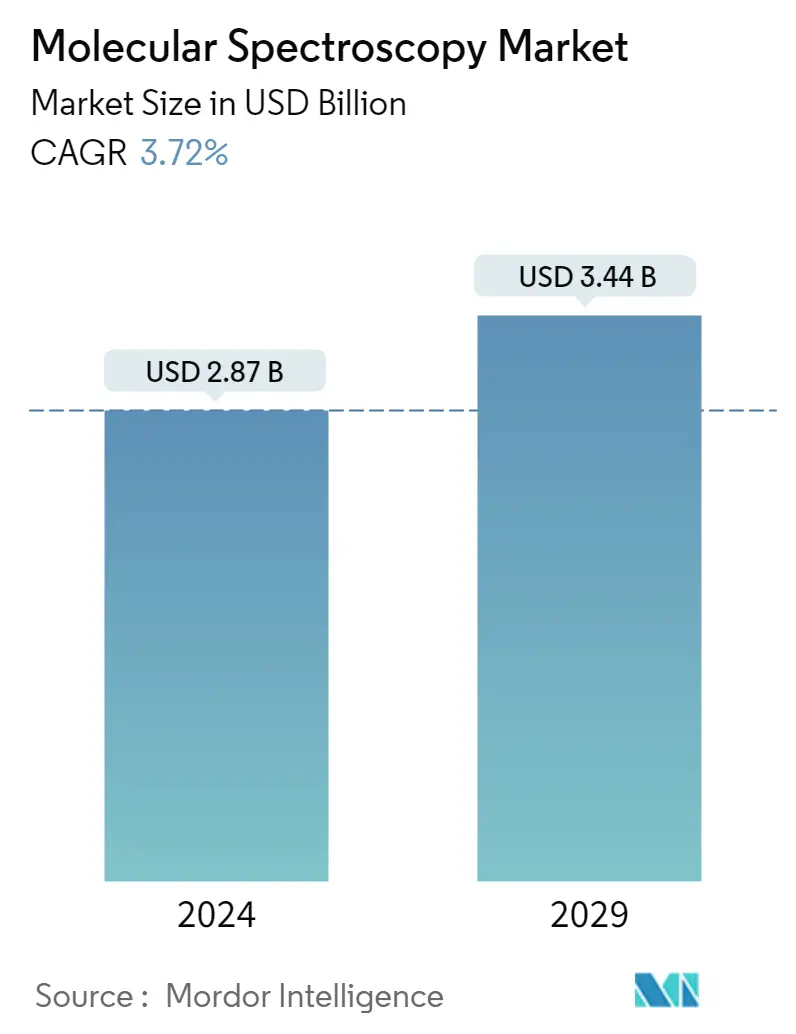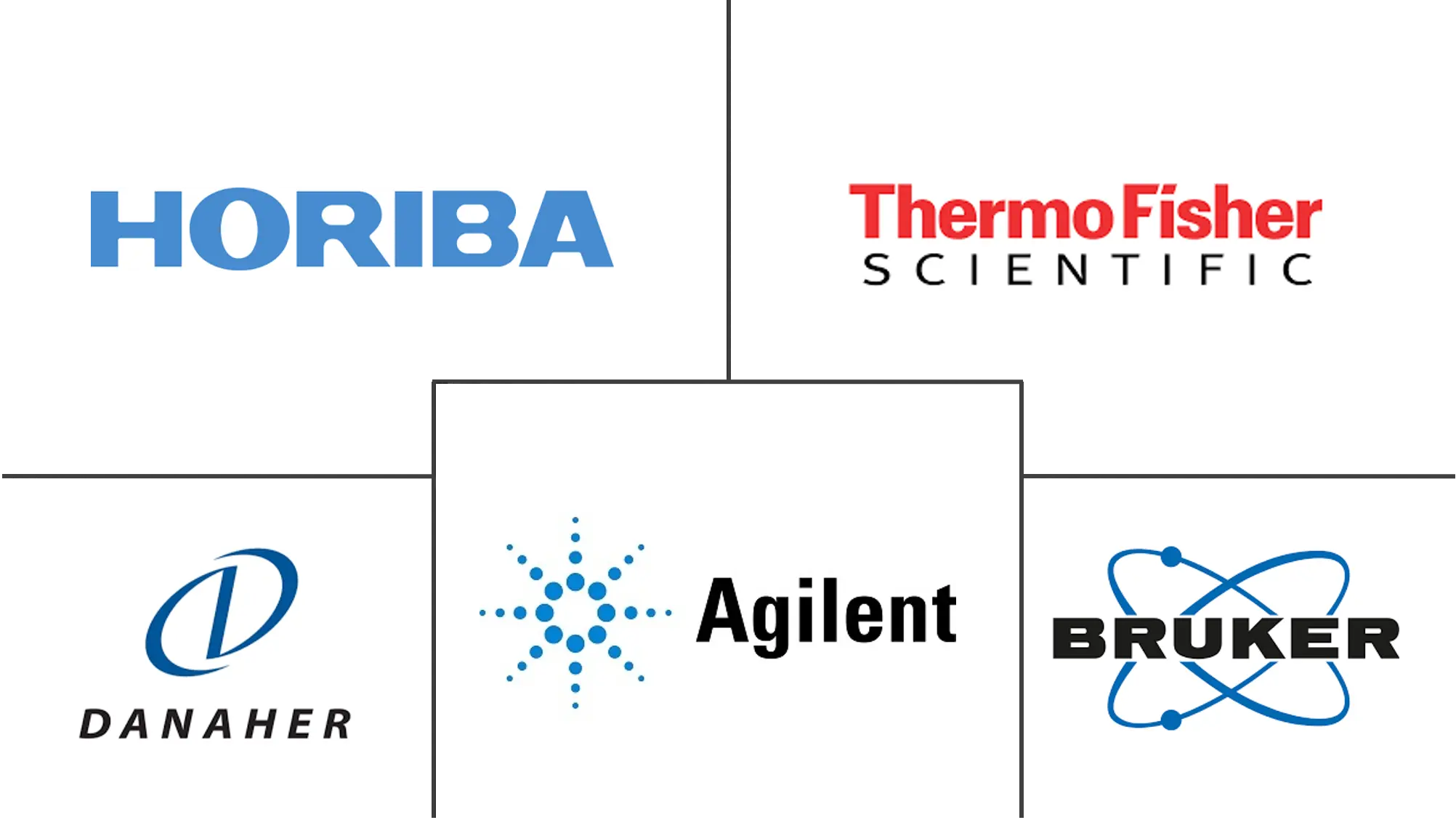Market Size of Molecular Spectroscopy Industry

| Study Period | 2019 - 2029 |
| Base Year For Estimation | 2023 |
| Market Size (2024) | USD 2.87 Billion |
| Market Size (2029) | USD 3.44 Billion |
| CAGR (2024 - 2029) | 3.72 % |
| Fastest Growing Market | Asia Pacific |
| Largest Market | North America |
Major Players
*Disclaimer: Major Players sorted in no particular order |
Molecular Spectroscopy Market Analysis
The Molecular Spectroscopy Market size is estimated at USD 2.87 billion in 2024, and is expected to reach USD 3.44 billion by 2029, growing at a CAGR of 3.72% during the forecast period (2024-2029).
The major factors driving the market include the rapid adoption in the pharmaceutical industry, penetration of MS technology in various verticals, and increased emphasis on the discovery of newer molecules by pharmaceuticals.
The growing COVID-19 pandemic has also had a positive impact on the market as scientists are increasing the applications of Raman spectroscopy for COVID-19 testing. For instance, a Northern Arizona University (NAU) research team was found developing a new test technology for SARS-CoV-2 using single-molecule surface-enhanced Raman spectroscopy (SM-SERS). The project was named 'Development of a New Test for SARS-CoV-2 Using Single-Molecule Surface-Enhanced Raman spectroscopy' and was awarded a USD 200,000 grant from the National Science Foundation's Rapid Response Research (RAPID) funding program. Therefore, with the increase in research and development activities by pharmaceuticals related to drug discovery, the demand for molecular spectroscopy is consistently expected to rise over the forecast period.
Molecular spectroscopy is being used in the research and development (R&D) of pharmaceuticals and other biotechnology products, and one of the molecular spectroscopy types used in R&D is near-infrared spectroscopy (NIR). In recent years, NIR spectroscopy has also gained a wide appreciation within the pharmaceutical industry due to its major advantages over other analytical techniques that include easy sample preparation and the expectation of chemical and physical sample parameters from one single spectrum. Therefore, the rising affinity toward this technology has been widely noted, which may drive the growth of the market.
Molecular spectroscopy is also found to be widely adopted across different application sectors, including pharmaceuticals and many others. Raman spectroscopy has proven to be a strong analytical technique for drug discovery and pharmaceutical development.
It is being used to study the structural activity relationships and optimize the reaction conditions and other parameters, such as polymorph and formulation screening, which lead to the scaling up required for the transfer of drug compounds from discovery to development. Hence, the market is expected to grow rapidly during the forecast period.
Molecular Spectroscopy Industry Segmentation
As per the scope of the report, molecular spectroscopy is the qualitative and quantitative study of molecules by observing their interaction with various frequencies and energy, and in another way, it is the study of the absorption of light by molecules. It is analyzed by ultraviolet (UV) light, visible light, and infrared radiations using an instrument called a spectrometer.
The molecular spectroscopy market is segmented by type of spectroscopy (NMR spectroscopy, Raman spectroscopy, UV-visible spectroscopy, mass spectroscopy, infrared spectroscopy, near-infrared spectroscopy, and other types of spectroscopy), application (pharmaceutical applications, food and beverage testing, biotechnology and biopharmaceutical applications, environmental testing, academic research, and other applications), and geography (North America, Europe, Asia-Pacific, Middle-East and Africa, and South America). The market report also covers the estimated market sizes and trends for 17 different countries across the major regions globally. The report offers the value (in USD million) for all the above segments.
| Type of Spectroscopy | |
| NMR Spectroscopy | |
| Raman Spectroscopy | |
| UV-visible Spectroscopy | |
| Mass Spectroscopy | |
| Infrared Spectroscopy | |
| Near-infrared Spectroscopy | |
| Other Types of Spectroscopy |
| Application | |
| Pharmaceutical Applications | |
| Food and Beverage Testing | |
| Biotechnology and Biopharmaceutical Applications | |
| Environmental Testing | |
| Academic Research | |
| Other Applications |
| Geography | ||||||||
| ||||||||
| ||||||||
| ||||||||
| ||||||||
|
Molecular Spectroscopy Market Size Summary
The molecular spectroscopy market is poised for significant growth, driven by its increasing adoption in the pharmaceutical industry and its expanding applications across various sectors. The technology's ability to facilitate drug discovery and development, particularly through techniques like Raman and near-infrared spectroscopy, has garnered substantial interest. These methods offer advantages such as easy sample preparation and comprehensive analysis from single spectra, making them invaluable in research and development activities. The COVID-19 pandemic has further accelerated the market's expansion, as molecular spectroscopy techniques have been employed in testing and research related to the virus, enhancing their relevance and application scope.
North America is a key region propelling the molecular spectroscopy market, supported by robust pharmaceutical activities and favorable government policies. The United States, in particular, stands out as a leader in biopharmaceutical research and development, with significant investments in drug discovery. The market is moderately competitive, with major players like Thermo Fisher Scientific, Agilent, Bruker, and Danaher leading the charge through strategic collaborations and technological advancements. These companies are actively involved in launching new products and expanding their market presence, which is expected to drive further growth in the coming years.
Molecular Spectroscopy Market Size - Table of Contents
-
1. MARKET DYNAMICS
-
1.1 Market Overview
-
1.2 Market Drivers
-
1.2.1 Rapid Adoption in the Pharmaceutical Industry
-
1.2.2 Penetration of MS Technology in Various Verticals
-
1.2.3 Increased Emphasis for Discovery of Newer Molecules by Pharmaceuticals
-
-
1.3 Market Restraints
-
1.3.1 High Cost of Maintenance and Installation Charges
-
1.3.2 Need of Technically Skilled Personnel
-
-
1.4 Porter's Five Forces Analysis
-
1.4.1 Threat of New Entrants
-
1.4.2 Bargaining Power of Buyers/Consumers
-
1.4.3 Bargaining Power of Suppliers
-
1.4.4 Threat of Substitute Products
-
1.4.5 Intensity of Competitive Rivalry
-
-
-
2. MARKET SEGMENTATION (Market Size by Value - USD million)
-
2.1 Type of Spectroscopy
-
2.1.1 NMR Spectroscopy
-
2.1.2 Raman Spectroscopy
-
2.1.3 UV-visible Spectroscopy
-
2.1.4 Mass Spectroscopy
-
2.1.5 Infrared Spectroscopy
-
2.1.6 Near-infrared Spectroscopy
-
2.1.7 Other Types of Spectroscopy
-
-
2.2 Application
-
2.2.1 Pharmaceutical Applications
-
2.2.2 Food and Beverage Testing
-
2.2.3 Biotechnology and Biopharmaceutical Applications
-
2.2.4 Environmental Testing
-
2.2.5 Academic Research
-
2.2.6 Other Applications
-
-
2.3 Geography
-
2.3.1 North America
-
2.3.1.1 United States
-
2.3.1.2 Canada
-
2.3.1.3 Mexico
-
-
2.3.2 Europe
-
2.3.2.1 Germany
-
2.3.2.2 United Kingdom
-
2.3.2.3 France
-
2.3.2.4 Italy
-
2.3.2.5 Spain
-
2.3.2.6 Rest of Europe
-
-
2.3.3 Asia-Pacific
-
2.3.3.1 China
-
2.3.3.2 Japan
-
2.3.3.3 India
-
2.3.3.4 Australia
-
2.3.3.5 South Korea
-
2.3.3.6 Rest of Asia-Pacific
-
-
2.3.4 Middle-East and Africa
-
2.3.4.1 GCC
-
2.3.4.2 South Africa
-
2.3.4.3 Rest of Middle-East and Africa
-
-
2.3.5 South America
-
2.3.5.1 Brazil
-
2.3.5.2 Argentina
-
2.3.5.3 Rest of South America
-
-
-
Molecular Spectroscopy Market Size FAQs
How big is the Molecular Spectroscopy Market?
The Molecular Spectroscopy Market size is expected to reach USD 2.98 billion in 2025 and grow at a CAGR of 3.72% to reach USD 3.57 billion by 2030.
What is the current Molecular Spectroscopy Market size?
In 2025, the Molecular Spectroscopy Market size is expected to reach USD 2.98 billion.

